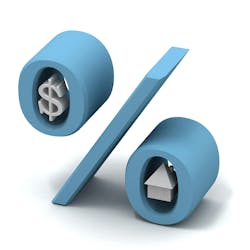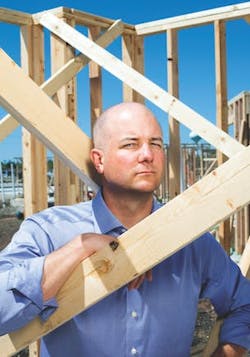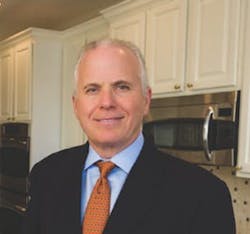LGI Homes would be ready to go public once it closed at least 2,000 houses a year, a benchmark that was probably a couple of years away, or so Eric Lipar thought. But when Tri Pointe Homes, an Irvine, Calif., builder with 144 closings in 2012, raised $156.3 million in net proceeds from its IPO in January 2013, Lipar knew the time was right to take his Houston-based company public.
“It really was a signal that the market was open to smaller companies because Tri Pointe was essentially a startup,” says LGI’s chairman and chief executive officer. “Even though (Tri Pointe) had a very nice balance sheet with really good equity, they were just starting to get closings into the company. When we saw that, we wanted to get out there before that window closed.”
Before LGI completed its $90-million offering last November, Lipar and his team made several stops at various providers of capital along a journey that started when the company closed its first house in 2003. That trek, in a sense, encapsulates the varied sources of money that home builders are tapping—private equity, public debt, and the common stock market—ever since banks pulled back on credit after the start of the housing market collapse in 2007.
“Financing has changed in the sense that there is a more diverse range of sources available and needed,” says Dave Ledford, senior vice president of housing finance and regulatory affairs for the National Association of Home Builders. “I think that this will be more than just a temporary sign because community banks are not going to be able to have 80 percent of their portfolios in construction and development loans going forward. The regulators made that very clear.”
The go-go years
The stretch between 2003 and 2006 was a good one for LGI as it was for builders in general. Closings for the company steadily increased to 418, and bank credit lines were readily available. LGI had aspirations to be a multiregional builder. On the construction side, its business model focused on building entry-level homes with a yard, priced as low as $115,000. A steady inventory of move-in ready product was created by setting building activity against projected closings, not executed contracts, and the even-flow construction schedule was managed to finish a house within 45 to 60 days from breaking ground.
On the sales front, LGI blanketed Houston and San Antonio apartment complexes near its subdivisions every five weeks with direct mail pieces announcing that it could turn renters into homeowners through no frills, no down-payment mortgages—typically mortgages backed by the Federal Housing Administration or the U.S. Agricultural Department’s rural housing program—that cost less than or were on par with the target market’s current monthly rent. Those mailers generated as many as 100 leads a week.
“We have a very disciplined and systematic approach to our sales process, our direct mail, and with our construction staff. When you look at our growth strategy, we have the system, we have the process, and all we’re doing is duplicating it and opening stores across the country similar to a franchise concept,” Lipar says.
The builder had designs in 2006 to grow to 1,000 closings by 2012. Then the downturn hit. Banks stopped lending, and LGI’s primary source of construction loans announced it was getting out of the Texas market. Without more capital, the company’s growth plans were in jeopardy.
So LGI’s management team sought friends and family financing. Lipar set up a private placement memorandum and raised $2.1 million from employees, trade contractors, and friends—17 individual investors in all, kicking in at least $100,000 each. They were told that in three-to-five years the return on their investment would be about 20 percent. With that capital, LGI entered the Dallas/Fort Worth market by acquiring 210 foreclosed lots in the Deer Creek community and was building houses there by 2009. Still, LGI needed more capital to reach its next growth phase, particularly since land was priced at a bargain thanks to the Great Recession.
“In 2009 and going forward, that’s when we saw opportunities to buy distressed finished lots with lower replacement cost, and that’s when we got really excited about going down the road to raise private equity and raising friends and family capital to do whatever we needed to do to take advantage of those opportunities,” Lipar says.
In March 2010, the builder picked up a $50-million infusion from Golden Tree Insite Partners, a New York-based real estate investment firm now called GTIS Partners. With that cash, LGI purchased 175 lots in the Chisholm Spring subdivision in Fort Worth, and 393 lots across the street from its Canyon Crossing community in San Antonio. The following year, LGI planted a stake in Phoenix, buying 103 lots in San Tan Heights, and then Austin, Texas, by purchasing 102 lots in the Sonterra development. In 2012, LGI launched in Tampa, and last year in Atlanta, Orlando, Albuquerque, and Tucson.
Expansion barriers
The builder closed over 1,000 homes going into last year, but pushing even higher created hurdles with private equity. LGI needed even more upfront capital to develop land and break into growth markets—an exercise that required more time than the period private equity investors typically allot before collecting their 20-plus-percent return on investment. Banks were not an option, and LGI seemed to be another 1,000 closings and years away from being IPO ready. But after Tri Pointe became the first home builder to go public since 2004, LGI quickly followed suit.
“We went as fast as we could to prepare for it,” Lipar says. “This was not an exit strategy. This was an event to help us further grow in the future, so the multiple we went out at, and the price to earnings ratio we went out at wasn’t important to us. The important thing was getting out and getting the capital raised so we could grow the company in the future.”
The public road
A total of six builders—Taylor Morrison, WCI Communities, UCP, and William Lyon also completed IPOs—went public last year. The New Home Company, Aliso Viejo, Calif., finished its $86-million offering in January and Newport Beach, Calif.-based City Ventures is scheduled to debut on the public market this year. When it does, the industry will have 24 publicly traded companies that predominantly build detached single-family homes, the most since 2005.
And why not? Wall Street had an appetite for new investment opportunities after sitting on the cash sidelines during the slow economic recovery. Last year, capital raised by IPOs from U.S. issuers jumped 40.5 percent to $57.1 billion (201 deals) compared with $40.6 billion (126 deals) in 2012, according to Thompson Reuters. Top builders that were able to hold onto or get access to land and upscale move-up and move-down buyers rebounded early last year. When those builders sought to sell common stock in order to raise capital and buy land, investors were eager to get in on the action.
Doug Bauer, Tri Pointe’s chief executive officer, jokes that perhaps he should collect a “finders fee” or some sort of rebate as a result of other builders going public after his company’s IPO. He admits that he would have doubted back in August 2012 whether there was an IPO market for his company. But $150-million financing from Starwood Capital, a clean balance sheet, and quality management eventually added up to a compelling lure for investors. One negative since going public is the company incurs more accounting and legal expenses related to compliance with the Sarbanes-Oxley Act—a cost of equity that the builder didn’t have when it was private. But Bauer calls that more of a change than a negative.
“Frankly, I’d be a public company in any industry, especially home building,” Bauer says. “It imparts a certain amount of discipline that I think makes a company a better operator and a better steward of its capital so you can survive the ups and downs.”
After its January IPO, The New Home Company moved on the $74-million purchase of Arantine Hills, a proposed master plan development in Corona, Calif. The site is surrounded by established communities, already sits within a school district, and will have somewhere between 1,300 to 1,600 new-home sites. That deal would not have been possible without the builder raising money through its January IPO, says Larry Webb, chairman and chief executive officer.
“I’ve been doing this for 30 years and during most of my career, during the good times and good market conditions, the capital was very plentiful for both the private and public builders,” Webb says. “But coming out of this recession, private builders have a much more difficult time having access to capital.”
The private side
Perhaps the debate about the advantages of public versus private is not as salient as discussing whether a builder is large enough and well-capitalized enough, which can be the case whether the company sells stock or is privately held, says Joel Shine, chief executive officer of Woodside Homes, Salt Lake City. Last September, the privately held builder raised $220 million in 6.75-percent senior unsecured notes due in 2021. He says that a downside with being public is the headline noise that can affect share price regardless of the company’s performance.
“I was talking to one of the public builder CEOs, and he said ‘I’m growing by 10, 20, 30 percent, and my stock gets dinged because the analysts think that it should be growing by 40 percent,’” Shine says. “‘They don’t understand that growing that fast has a downside, but because they decided that is how fast I should grow, they’re going to ding me for it.’ There are some extremely savvy, smart analysts out there, the Ivy Zelmans of the world and a small handful of others. Then there also are some guys out there who call me, they say stuff, and I scratch my head, and I just go, ‘Really?’”
Public debt
Builders were among the many private and public U.S. companies that also took advantage of relatively cheap money by issuing public debt in 2012 and 2013. Issues in the U.S. investment grade market reached $1.02 trillion last year, topping the previous all-time high of $1.01 trillion set during the previous year, per Thomson Reuters. That push was partially the result of companies trying to beat rising interest rates during the second half of last year after the Federal Reserve Board signaled that it was considering reducing its monthly bond purchases, which had kept rates stable.
Well before that rush, David Weekley Homes, Houston, in February 2013 issued $200 million of senior unsecured debt due in 2023 at 6-percent interest, one of the more favorable terms for a private builder. The money was raised through a 144A-for-life bond offering, which carries reporting requirements, but the privately held builder only discloses its numbers to investors who are qualified to buy the bonds. That avenue was an attractive alternative to other forms of issuing debt or raising money in the public market, particularly if shareholders and Wall Street analysts pushed for dividend payouts or buybacks at the expense of such Weekley practices as profit sharing with employees and donating 20 percent of pretax earnings to charity. The builder used the bond money to pay down bank lines.
“The cost of public debt was 1-to-1.5-percent higher (than bank line rates available at that time), but what you’re paying for is the interest risk rate,” says Heather Humphrey, Weekley Homes’ chief financial officer. “Revolving rates are not staying put, we’re locking in at 6 percent for 10 years. All other borrowing is variable. That’s about the lowest fixed rate we’ve ever seen.”
William Lyon Homes, Newport Beach, Calif., also took advantage of lower interest rates in 2012 by refinancing a $235-million and 10.25-percent interest term loan due next year with a $325-million issue of senior notes with 8.5-percent interest. Lyon raised another $150 million to buy 540 infill lots in Orange, Los Angeles, and Santa Clara counties in California with a 5.75-percent senior note issue completed in March. Other builders that have dipped into the high-yield market for capital recently include D.R. Horton, Fort Worth, Texas; Beazer, Atlanta; Hovnanian, Red Bank, N.J.; Lennar, Miami, and Ashton Woods, Roswell, Ga.
But raising capital through bonds, obviously, is not available for smaller builders. Humphrey, Bauer, and Lipar agree that a $200-million issue is the minimum buy-in for issuing public debt. Anything less makes the bond too expensive for the issuer.
Private equity partner
Some builders raised capital through partnerships with equity investors willing to take an ownership stake or set up a joint venture. Mountain Real Estate Capital LLC, with offices in Minneapolis, Charlotte, and San Diego, has committed $800 million through about 60 deals in the past four years. Many of the partners are builders that some Mountain employees worked with since their days with GMAC’s construction lending group. Mountain’s investments range from $5 million to $75 million with the average deal size being about $12 million. Some deals are short two-to-three-year partnerships; others are six-to-eight-year stretches, and some of its builder partners have visions of going public in two-to-five years.
“We’ve found that if a builder is at 150 homes or more (a year), we are a pretty good partner for them,” says Joel Kaul, Mountain’s managing director. “If they’re under 150 homes, it’s hard for us as institutional investors to figure out how we’re going to help them grow their business.”
He explains that a smaller builder with $5 million in capital doesn’t need an equity investor because he can just “recycle that capital through his home building company.” But a builder with 150 to 200 closings has outgrown his friends and family financing. If that builder wants to double his production, his company probably needs another $5 million to $15 million to do so.
“We’re a really good resource for the builder to partner with. We move a lot of their new projects into a joint venture, and then we finance the land acquisitions, development, and home building in our partnership. We are more expensive than debt, but it is a great structure for a conservative builder who wants to grow, but doesn’t want to sign up for a bunch of debt right now,” Kaul says.
The financing gap
Banks will still be the dominant provider of credit but, like equity investors, they will be very selective and favor large companies with stellar balance sheets. Small- and medium-sized builders are at a competitive disadvantage because even if the housing market returns to normal activity, there will be a gap that has to be filled with alternative capital sources since banks will not be able to carry the load they carried before the crash.
“We’d like to see our smaller builder members have access to credit and not be at a competitive disadvantage, but presently it’s hard to argue that they are not,” says Ledford of the NAHB. “That is why we are trying to level the field in that regard.”
Details are in the works, but Ledford says that such a program could launch this year. Unlike previous hodgepodge efforts that tried to match builders with financing preferences until the program ran its course, the NAHB is developing a plan to continuously provide capital on a regular basis.
“(It’s) sort of like how the commercial paper market works for you. You’re able to keep the money flowing from investors, and there’s an intermediary working for you servicing the loans so the investors don’t have to be concerned about that, and there’s confidence in the process,” Ledford says. “That’s the key: to get confidence in the process so the investors don’t have to look through every little detail in how the money is applied and repaid. As long as that happens, they should be satisfied and do it at a cost that is workable for the builders.”
Credit watchers such as Experian Information Solutions, Fitch, and the Federal Reserve note that banks are loosening lending standards and underwriting more mortgages and business loans. Although banks will remain the main provider of capital, there is a financing gap that will have to be filled by an alternative money source—or not. Nevertheless, the industry will have to reckon with the notion that the Great Recession has fundamentally changed how builders acquire financing.
“For most of my career when looking at the home building industry, I have felt that about 50 percent of new homes went to private builders and the other 50 percent went to the public builders,” says Webb of The New Home Company. “Moving forward I really believe that five years from now, you’re going to see that 75 percent of houses sold in America are from public builders. There will always be well-run private companies; but public builders, because of their access to equity, will have an incredible competitive advantage, and I don’t see that changing in the short term.” PB
Photo of Eric Lipar courtesy of Ben Sklar/DBPhotoAgency
Sign-up for Pro Builder Newsletters
Get all of the latest news and updates.





